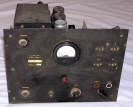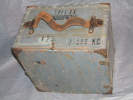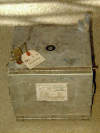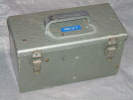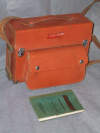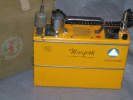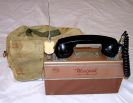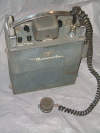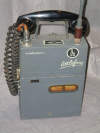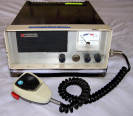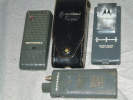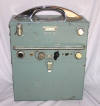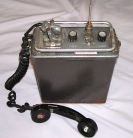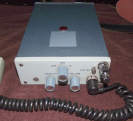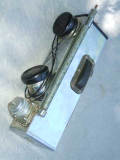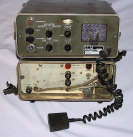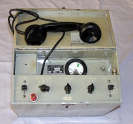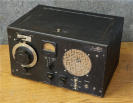|
|
|
|
|
|
Other portable radio gear |
|
Credits for most of the pictures and informations for this topics are owed to: Ch*** , who does not want to be named; and Geoff, WB6NVH                        
Forest Service AM transmitter, AC line powered. 5Z3 rectifier, 2X 6L6G modulators, 807 amplifier. Model number is not known. It is maybe from about 1944-45. Tuned circuits of the amplifier can be measured at approx. 27-40 MHz. It is interesting in that there is a bandswitch which changes all tuned circuits when you change from Channel 1 to Channel 2! This way the frequencies could be far apart.
It was built by "State Forestry Dept" from a late 1930's design. This radio proves, it is possibile for people to do something useful if directly given tax money... Yet no other examples have been found :-) For its era, this is a very small set of 270 x 250 x 180mm which carried its batteries in the lower compartment. The house is plywood, microphone is a standard W.E.Co carbontelephone type and the receiver is superregenerative with RF preamplifier. Notice of the 7 tubes, 2 are B7G in "wide" sockets to fill holes made for octals, so this example is likely a later production unit of perhaps early 1940's. The tube complement is 1N5, 1T4, 1T4, 1A5, 1Q5, 1A5, 1Q5. Like many fire watch radios, it is 10M, 31.580MHz precisely. Sadly however, this one has open windings on 3 of the 4 AF transformers.
This HF AM radio was designed for the US Forest Service ca 1947. It was an ugly but well designed radio which made good use of an abundance of military surplus parts then available, including handsets, tubes, antennae and small components. It was made to employ a telescoping antenna when portable, or long wire if set up in a fire watchtower. Most if not all examples of SPF are bare aluminum. A prominent feature of these radios is their multimeter which besides antenna tuning, was for testing the batteries in situ (very important).
made in August, 1959. It was used on a frequency of 33.98 MHz by the Oregon Department of Forestry. The extra space in the chassis is where a second receiver or transmitter could be mounted. Power would have been supplied by external batteries. The chassis inside are of stainless steel so still look beautiful after all these years. The chassis are basically the same as the Radio Specialty "Packmaster" and "Minipak" chassis. This one is a regular transmitter-receiver but it seems that these could be built as a repeater as well.
Another SPF forest service transceiver. There were a number of different designs, all called SPF. This one is a Generation II SPF, also called the "AA." The difference here is that this model saw the first use of octal-based battery tubes 1N5, 1A7 and 3Q5, which meant that the ballast tube for filaments could be eliminated and the filaments run directly from a 3 Volt battery. The SPF Serial # 336 uses 1.5 Volt GT octal tubes in the receiver only. The transmitter still uses ST style 2 Volt filament tubes with a filament rheostat. Older versions also used ST style 2 Volt filament tubes in the receiver, and those required a ballast tube (Type 1B1 tube) to drop 1 Volt from a 3 Volt battery to 2 Volts. Transmitter is 2 Watts on 3 MHz, crystal controlled, AM. Receiver is tunable, in the 3 MHz range. Most strange is that the microphone on this model was permanently affixed to the inside box top, and had no cable. So, to transmit, the operator had to shout into the box!
according to all date codes found on its parts. The early date does not agree with published history of Morrow, reason unknown. This tiny set was made for the US Forest Service, and operates on 9M AM. Its receiver is superregenerative with RF pre-amplifier.
This portable HF (2...6 MHz) radio was made for Canada Ministry of Natural Resources ca 1959. It was used by forestry services and survey parties. Itís a light and simple design, but very effective for its intended service. Receiver is superhet, and the 2 transistors are AF final stage for both modulation and reception. TX is 2W. The antenna is either a long wire, or rod with tuneable base load coil, which was deployed at camp as needed. As with some American HF forestry radios, it's multimeter permits testing of the battery ensemble. The leather satchel and heavy shoulder strap hint at life on the trail.. For more infos on forestry radio gear, see "Radio For The Fireline" by Gary Craven, an excellent treatise on the development of communication gear for the wilderness of N. America.
This was designed for the US Forest Service, and probably the best of this companyís wares. Itís 9M FM, and has 2 complete transmitters in the standard configuration. It was made for rough service, usually the only communication link to watchtowers. The transmit decks produce ~1.5W, but many also have a switchable PA with 7W output. 7W was only possible if powered by an external PS unit (typically in a vehicle) Telescoping antenna is stored in the hollow grip.
with Civil Defense logo. This unit of ca 1960 is one of the last models produced by Radio Specialty, because sadly they did not improve their designs to best use new technology. Compared to their Packmaster of 1953, one can see very little change besides the 3-transistor AF amplifier in this unit. Minipak was also used by USFS.
transmitter-receiver. These were made in the 1950's through about 1965 and this one is basically the same as the yellow one shown up page except that this one has no speaker, it is for the handset only. It is still tuned on two 171 MHz frequencies, i.e. 171.425 and 171.475 MHz. The model number is 1160-6-1. This one was probably used by the U.S. Forest Service. They were also made as Low Band (30-50 MHz) models and there was an accessory canvas carrying bag for it. All wire-lead subminiature tubes inside.
This is a low band unit which is still in its canvas carrying case (case in poor condition!) You can see the Radio Specialty "logo" on the case. This one is model 1160-276-1-N. The "N" probably means narrow band, as this radio was built in 1962 and the FCC required stations to operate narrow band after that year. The frequency (low band), of this one is 31.34 MHz. For public service and commercial radio gear, transistorisation was no advertising gimmick, although it certainly helped. There were 4 specific demands which called for improvement as follows: Even so, this power was not sufficient in a noisy environment and Motorola found it necessary to put their speaker in a hinged box, allowing it to be "aimed" at the user. A 3V4 needs 100mA of heater current, compared say with the 6088/DF61 IF stages which consume 20/25mA each, so this AF amplifier could easily increase total standby heater current 1.5x in such a radio, and still only give weak audio. The solution was either a squelch relay to control the AF filament (Packmaster), huge batteries (Packset), or transistors (which gave sufficient AF power).
These were made in 2M and 8...6M variants beginning around 1950, and were notable for their modular design. Each stage may be pulled out of its cell for replacement. They were offered with a variety of options, e.g., dry batteries or vibrator power supply with accu, 1 or 2 frequency. The same modular concept was used in a smaller version, the FHTR "lunchbox" radios (civilian and military), and also in military PRC-21. Here similar plug-in circuits were employed, but in a different arrangement because the smaller radios only contain 1 hive of cells. This may be the first American example of interchangeable modular circuitry, possibly influenced by Lorenz designs of the 1930s.
This radio has a vibrator anode supply like the Littlefone, also powered by 2v lead accu. A version with dry battery box on the bottom is smaller by a slight amount than the one shown on the picture. The wiring inside the Trailmaster looks like a bird's nest, but it works well! All subminiature wire-lead tubes inside. There is a white plastic lamp lens on the panel with a neon lamp inside. When the set is on, the neon lights, to tell you the battery still has good voltage. It is also called the "Trailmaster" and was popular with railroads as well as forestry.
was made in the early 1950's. It's a 6M transceiver with 22 subminiature tubes. It has a vibrator anode supply, powered by 2 parallel 2v accus, and has 2 simple printed circuit strips under the chassis which connect A+ and B+ to many circuits.
The circuitry is basically the circuit boards from Motorola's HT 200 portable "Handie Talkie" but with a carrier-operated relay added, along with battery and power metering. They were made in both UHF and VHF versions. This one is a VHF version operating in the 169 and 171 MHz range, as used by the United States Forest Service. The lookout radio could be configured as a repeater or a regular transmitter-receiver. This example was used as a regular set and not a repeater, however the extra antenna connector is in place for a repeater. These were sold from about 1965 through 1970.
These were the first first "handy" FM radio gear from 1959, and the first version of transmitter was actually tube technique (and bigger, it had a microphone on cord). This example is from 1961 and is fully transistorized.
Using all wire-lead subminiature tubes, they are a portable FM set made about 1955-1962 in either 30-50 MHz or 150-174 MHz bands. The battery box is in the bottom section and there is also a connector for an external power supply. These are rare today, they were popular in civil defense organizations in the 1950's.
Some of the tubes are DL94, DF92 and DL73. The nickel plated ring around the panel must have been intended as a carrying handle, but it is so close to the panel that no fingers can get underneath it to use it for that!
is an English radio, built by PYE. This model came in AM of FM, also as 70- 120- or 150- MHz - version. It is fully transistorized and uses AA batteries. In the USA is was sold by "Aircraft Radio Corporation" as "ARC". The version shown here on 121.5 MHz in AM was used about 1968 .. 1978 by the Oregon Department of Forestry; to talk to their airplanes. There is a wire antenna hidden inside the leather shoulder strap, which you can plug into the radio set and not use the pull-out antenna. The microphone can be used as a speaker, but I found that the audio is very low that way.
Manufacture began in 1948, about 16 months before PRC-6. These operate in the 8m band, and like many other USFS radios of the aera, has 2 complete transmitters. It uses 2 types of 8-pin submini tube; 1C8 and 1W5, and has 29 (!) in total. The only control of the early model is a channel selector switch, it's turned on by screwing in the telescoping aerial. The later variant also has power switch and 2 connectors for aircraft use; the large one for a headset, and a small coaxial socket for external antenna. The black wire wound round the ear/mic parts is a counterpoise which connects to chassis via a tuned circuit, and could be extended for weak signal operation. Its house and battery cassette are stainless steel, weighs 4Kg
Some radios say "Motorola" and others say "CAI" on the nameplate. Howie, AB2S explains it: ==> The SA-200 was designed and manufactured by CAI (Communications Associates Inc.) for Motorola. The contract allowed CAI to sell equipment under their own name to selected markets, so it's possible to find the same radio with both manufacturer names and different model numbers, I think the Motorola SA-200 was a CAI CA-32. The radios are identical in all respects. The radios were produced and put into inventory without nameplates. When an order came in, the appropriate name plate was installed during final test. CAI also made the Motorola SA-100 and SA-900 hybrid tube SSB transceivers.<== The microphone is the same as used on the Motorola PT300 pack set radio. This model dates from 1968, is fully solid state. 20 watts output. Originally there was a nicad battery pack which clipped on the back end of the radio when in storage. The case which clips on the front end is a combination AC power supply and battery charger. The battery pack is missing on this radio. There was also an antenna tuner box, which clipped on as a front cover of this set, instead of the power supply, but they are very rare. This radio was used by the U.S. Government Bureau of Land Management (BLM.) 2 channels only, but has both upper and lower sideband. Power is automatically reduced to 2W when only the battery is used.
There are crystals in it for a 5.2 MHz frequency. AM voice. The cartridges inside the handset are dated 1957. It uses 1 Volt miniature 7-pin tubes and must have been intended to fit inside a back pack or canvas carrying sack because there is no handle. None are known to have been used in the USA.
The CCC lasted until 1943. They did things like planted seeds in national forests, cut trees, made roads and dams, trails, that sort of thing. The CCC used CW radio nets on the 2.5 MHz range to communicate with each other. It is CW only and no AM voice and it uses a common 6A6. This radio was used by the Grazing Service, which took care of the government's renting fields of grass in national parks to cow and sheep farms. The government made good money renting forests to farmers for cows. In 1943 the CCC was broken up and the men all went to the army or navy. Most or all the radio men in the CCC were also radio amateurs and interestingly, they seem to have taken the radios home with them when the CCC was over.
From the outside it looks almost the same as the Gracing radio, but inside is very much different! It has both AM and CW. It uses a strange RK34 double-triode power amplifier tube while the Grazing Service radio uses a common 6A6. I think the eBay radio might be from the National Parks Service, which was different than the US Forest Service. The eBay radio is missing the transmitter crystal but my test equipment says the transmitter circuits are tuned to just above 2.5 MHz. There is a separate box power supply for 6 Volt DC operation, which uses two vibrator packs. I got one with the CCC radio. The AC power supply is built inside both radios. A 15 pin "Jones" connector on the back allows AC or DC operation depending on how it is wired. I think the transmitter power output is about 5-8 Watts. The receiver is tunable, transmitter has one channel crystal.
|

